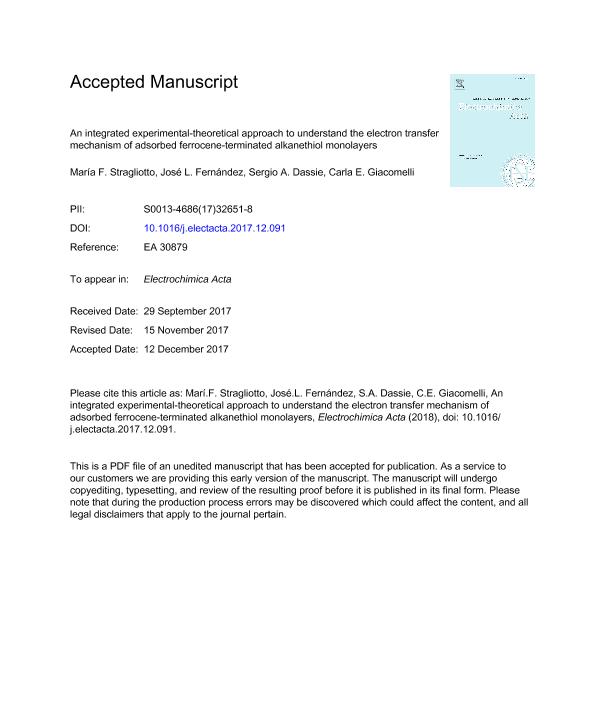Mostrar el registro sencillo del ítem
dc.contributor.author
Stragliotto, María Fernanda

dc.contributor.author
Fernandez, Jose Luis

dc.contributor.author
Dassie, Sergio Alberto

dc.contributor.author
Giacomelli, Carla Eugenia

dc.date.available
2019-12-04T21:25:21Z
dc.date.issued
2018-03-01
dc.identifier.citation
Stragliotto, María Fernanda; Fernandez, Jose Luis; Dassie, Sergio Alberto; Giacomelli, Carla Eugenia; An integrated experimental-theoretical approach to understand the electron transfer mechanism of adsorbed ferrocene-terminated alkanethiol monolayers; Pergamon-Elsevier Science Ltd; Electrochimica Acta; 265; 1-3-2018; 303-315
dc.identifier.issn
0013-4686
dc.identifier.uri
http://hdl.handle.net/11336/91440
dc.description.abstract
In this work, the electron transfer mechanism of self-assembled monolayers of 6-ferrocenyl-1-hexanethiol (FcC6SH) on Au(111) substrates is addressed from two perspectives. To acquire a complete overview of the involved pathways, cyclic voltammetry and scanning electrochemical microscopy (SECM) were combined using an integrated experimental-theoretical approach. In the first case, the electrochemical behaviour is evaluated in the light of computer simulations of the experimental voltammetric response measured at successive potential scans in different supporting electrolytes. Successive potential scans change the lateral interactions between adsorbed Fc molecules that affect the oxidation of the electroactive monolayer. Furthermore, ion-pair formation between the oxidized ferrocene moieties and the anions of the supporting electrolyte controls the electron transfer process as well as the type of the lateral interactions. In the second case, a thin-layer cell based formalism is used to develop a new model to understand feedback SECM experiments carried out with an additional redox mediator in solution. Since these experiments sense the parallel pathways of the electron transfer mechanism (pinholes and direct electron tunnelling and mediated electron transfer through the monolayer), the results are processed by using the new developed model for the analysis of the multipathway electron transfer mechanism. On that sense, the experimental results are processed by using the new SECM model accounting for the parallel electron transfer via the monolayer and the pinholes simultaneously.
dc.format
application/pdf
dc.language.iso
eng
dc.publisher
Pergamon-Elsevier Science Ltd

dc.rights
info:eu-repo/semantics/openAccess
dc.rights.uri
https://creativecommons.org/licenses/by-nc-nd/2.5/ar/
dc.subject
ELECTROACTIVE MONOLAYER– 6-FERROCENYL-1-HEXANETHIOL
dc.subject
SCANNING ELECTROCHEMICAL MICROSCOPY
dc.subject
SURFACE DOMAINS
dc.subject
TLC MODEL
dc.subject.classification
Físico-Química, Ciencia de los Polímeros, Electroquímica

dc.subject.classification
Ciencias Químicas

dc.subject.classification
CIENCIAS NATURALES Y EXACTAS

dc.title
An integrated experimental-theoretical approach to understand the electron transfer mechanism of adsorbed ferrocene-terminated alkanethiol monolayers
dc.type
info:eu-repo/semantics/article
dc.type
info:ar-repo/semantics/artículo
dc.type
info:eu-repo/semantics/publishedVersion
dc.date.updated
2019-09-30T18:28:16Z
dc.journal.volume
265
dc.journal.pagination
303-315
dc.journal.pais
Estados Unidos

dc.description.fil
Fil: Stragliotto, María Fernanda. Universidad Nacional de Córdoba. Instituto de Investigación y Desarrollo en Ingeniería de Procesos y Química Aplicada. Consejo Nacional de Investigaciones Científicas y Técnicas. Centro Científico Tecnológico Conicet - Córdoba. Instituto de Investigación y Desarrollo en Ingeniería de Procesos y Química Aplicada; Argentina. Universidad Nacional de Córdoba. Facultad de Ciencias Químicas. Departamento de Fisicoquímica; Argentina
dc.description.fil
Fil: Fernandez, Jose Luis. Universidad Nacional del Litoral. Instituto de Química Aplicada del Litoral. Consejo Nacional de Investigaciones Científicas y Técnicas. Centro Científico Tecnológico Conicet - Santa Fe. Instituto de Química Aplicada del Litoral.; Argentina. Universidad Nacional del Litoral. Facultad de Ingeniería Química. Programa de Electroquímica Aplicada e Ingeniería Electroquímica; Argentina
dc.description.fil
Fil: Dassie, Sergio Alberto. Consejo Nacional de Investigaciones Científicas y Técnicas. Centro Científico Tecnológico Conicet - Córdoba. Instituto de Investigaciones en Físico-química de Córdoba. Universidad Nacional de Córdoba. Facultad de Ciencias Químicas. Instituto de Investigaciones en Físico-química de Córdoba; Argentina. Universidad Nacional de Córdoba. Facultad de Ciencias Químicas. Departamento de Fisicoquímica; Argentina
dc.description.fil
Fil: Giacomelli, Carla Eugenia. Consejo Nacional de Investigaciones Científicas y Técnicas. Centro Científico Tecnológico Conicet - Córdoba. Instituto de Investigaciones en Físico-química de Córdoba. Universidad Nacional de Córdoba. Facultad de Ciencias Químicas. Instituto de Investigaciones en Físico-química de Córdoba; Argentina. Universidad Nacional de Córdoba. Facultad de Ciencias Químicas. Departamento de Fisicoquímica; Argentina
dc.journal.title
Electrochimica Acta

dc.relation.alternativeid
info:eu-repo/semantics/altIdentifier/url/https://www.sciencedirect.com/science/article/pii/S0013468617326518
dc.relation.alternativeid
info:eu-repo/semantics/altIdentifier/doi/http://dx.doi.org/10.1016/j.electacta.2017.12.091
Archivos asociados
